
Donkey Kong Country is a 1994 platform game developed by Rare and published by Nintendo for the Super Nintendo Entertainment System (SNES). It is a reboot of Nintendo's Donkey Kong franchise and follows the gorilla Donkey Kong and his nephew Diddy Kong as they set out to recover their stolen banana hoard from the crocodile King K. Rool and his army, the Kremlings. The single-player traverses 40 side-scrolling levels as they jump between platforms and avoid obstacles. They collect items, ride minecarts and animals, defeat enemies and bosses, and find secret bonus stages. In multiplayer modes, two players work cooperatively or race each other.

Balloon Fight is an action video game developed by Nintendo and HAL Laboratory and published by Nintendo. The original arcade version was released for the Nintendo VS. System internationally as Vs. Balloon Fight, while its Nintendo Entertainment System counterpart was released in Japan in 1985 and internationally in 1986.

Bad Dudes Vs. DragonNinja, also known simply as either Bad Dudes or DragonNinja, is a side-scrolling cooperative beat 'em up game developed and released by Data East for arcades in 1988. It was also ported to many computer and game console home systems.
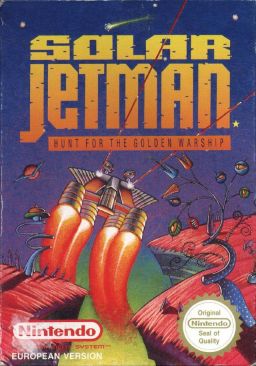
Solar Jetman: Hunt for the Golden Warpship is a multi-directional shooter video game developed by Zippo Games and Rare and published by Tradewest in North America and by Nintendo in Europe. It was released in North America on 14 October 1990 and in Europe on 26 September 1991 for the Nintendo Entertainment System. The game is the third installment of the Jetman series and was later re-released by Nintendo for their NES-based PlayChoice-10 arcade system in the United States in 1990.

Super R.C. Pro-Am is a racing video game developed by Rare and published by Nintendo for the Game Boy. It was released in North America in June 1991 and in Europe on April 23, 1992; it was re-released in 1998 as part of Nintendo's Player's Choice series, which included all Game Boy titles which sold over one million copies. It is the follow-up to the Nintendo Entertainment System (NES) title R.C. Pro-Am, in which players race remote control cars from an out-of-vehicle perspective on a series of 24 tracks, avoiding obstacles and collecting items to improve performance in order to finish in the top three and qualify for the next track. The game can be played solo against three computer opponents, or two to four players can play simultaneously via the Game Link Cable or the Four Player Adapter.
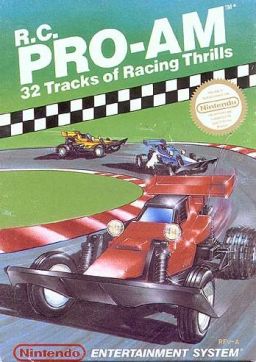
R.C. Pro-Am is a racing video game developed by Rare and published by Nintendo for the Nintendo Entertainment System. It was released in North America in February 1988, and then in Europe on April 15. Presented in an overhead isometric perspective, a single player races a radio-controlled car around a series of tracks in vehicular combat. Each track qualifies its top three racers for the next track. Collectible power-up items improve performance, hazards include rain puddles and oil slicks, and missiles and bombs can temporarily disable opponents. Originally titled Pro Am Racing, it was ported to the Sega Genesis in 1992 as Championship Pro-Am, an enhanced remake with enhanced graphics and additional features. R.C. Pro-Am spawned two sequels: Super R.C. Pro-Am in 1991, and R.C. Pro-Am II in 1992.

The Nintendo VS. System is an arcade system developed and produced by Nintendo from 1984 to 1990. It is based on most of the same hardware as the Family Computer (Famicom), later released as the Nintendo Entertainment System (NES). As Nintendo was planning to release the NES in North America, they were aware of the video game crash of 1983 and its effects on the home console market. However by March 1984 the arcade industry recovered enough for a plan to introduce NES titles there, with the VS. System later being a presentation to players who did not yet own the console. It became the first version of the Famicom hardware to debut in North America.
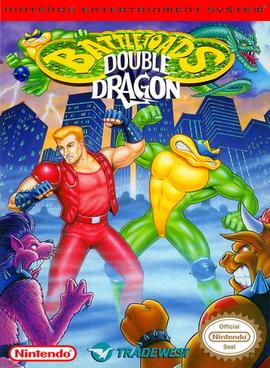
Battletoads/Double Dragon is a 1993 beat 'em up developed by Rare and published by Tradewest. It was originally released for the Nintendo Entertainment System and later ported to the Mega Drive/Genesis, Super NES, and Game Boy. Retro-bit Publishing has re-released the 8-bit NES version in early 2022 with plans to release the 16-bit versions later this year.

Snake Rattle 'n' Roll is a platform video game developed by Rare. It was published by Nintendo and released for the Nintendo Entertainment System in North America in July 1990 and in Europe on March 27, 1991. The game features two snakes, Rattle and Roll, as they make their way through eleven 3D isometric levels. A Mega Drive version was released by Sega in June 1993 with an extra level. Snake Rattle 'n' Roll was developed by Rare members Tim Stamper and Mark Betteridge. The music was composed by David Wise and was inspired by "Shake, Rattle and Roll" and other 1950s-era songs.

Wizards & Warriors, titled Densetsu no Kishi Elrond in Japan, is an action platform video game developed by Rare and published by Acclaim Entertainment for the Nintendo Entertainment System. It was released in North America in December 1987, and in Europe on January 7, 1990. The player controls Kuros, "Knight Warrior of the Books of Excalibur", as he sets out in the Kingdom of Elrond to defeat the evil wizard Malkil. Malkil holds the princess of Elrond captive in Castle IronSpire, deep within the forests of Elrond. The player fights through forests, tunnels, and caves, while collecting keys, treasure, weapons, and magic items.
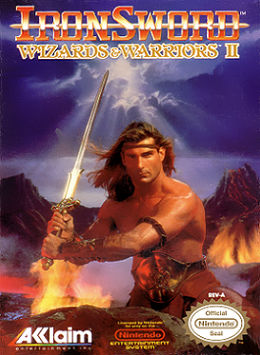
Ironsword: Wizards & Warriors II is a platforming action-adventure video game for the Nintendo Entertainment System (NES) developed by UK-based company Zippo Games, a subsidiary of Rare. The game was published by Acclaim and released in North America in December 1989 and in Europe on March 27, 1991. It is the sequel to Rare's 1987 title Wizards & Warriors. In Ironsword, the player controls the knight warrior Kuros as he ventures in the land of Sindarin. He must defeat the evil wizard Malkil, who has assumed the elemental forms of Earth, Wind, Fire, and Water. Kuros must collect the parts of and assemble the legendary "IronSword" in order to defeat Malkil, who resides at the top of IceFire Mountain.

Donkey Kong is a 1994 puzzle-platform game developed by Nintendo and Pax Softnica and published by Nintendo for the Game Boy. Donkey Kong is loosely based on the 1981 arcade game of the same name and its sequel Donkey Kong Jr.

Devil World is a maze video game developed by Nintendo and Intelligent Systems and published by Nintendo for the Nintendo Entertainment System. It was released for the Famicom in Japan on October 5, 1984, and for the Nintendo Entertainment System in Europe on July 15, 1987. It was re-released on the Wii's Virtual Console in Japan on January 22, 2008, and in PAL regions on October 31, 2008. Nintendo of America's content policies prohibiting religious icons prevented the game's release in North America. It is Shigeru Miyamoto's first console-only game after a legacy of arcade development, and for many years was his only game not to be localized to North America until it was released as part of the Nintendo Switch Online service in 2023.

Cobra Triangle is a 1989 racing video game developed by Rare and published by Nintendo for the Nintendo Entertainment System. The player controls a weapon-equipped speedboat through 25 levels. Objectives include winning races, saving swimmers, and defusing bombs. The game also includes vehicular combat, power-ups and is displayed from a 3D isometric perspective with automatic scrolling that follows the player's movement. The Stamper brothers designed the game and David Wise wrote its soundtrack. Computer and Video Games highly recommended the game and praised its graphics and gameplay. Later reviewers lauded its level diversity and noted its graphical similarities to previous Rare game R.C. Pro-Am. IGN and GamesRadar ranked Cobra Triangle among their top NES games. The latter considered Cobra Triangle emblematic of the NES era's aesthetic. It was also included in Rare's 2015 Xbox One retrospective compilation, Rare Replay.

Monster Max is a 1994 action-adventure puzzle video game developed by Rare and published by Titus France in Europe for the Game Boy. The player is the titular aspiring rock star, who, in an attempt to fight King Krond who bans all music, traverses nine floors of the Mega Hero Academy. Floors consist of diversely-designed rooms of puzzles to solve, the player having to figure out the order of actions to take.
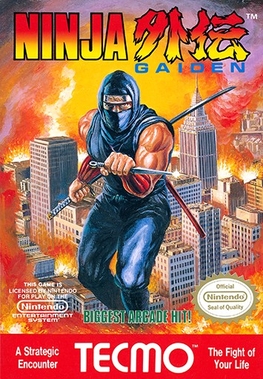
Ninja Gaiden, released in Japan as Ninja Ryūkenden and as Shadow Warriors in Europe, is an action-platform video game developed and published by Tecmo for the Nintendo Entertainment System. Its development and release coincided with the beat 'em up arcade version of the same name. It was released in December 1988 in Japan, in March 1989 in North America, and in August 1991 in Europe. It has been ported to several other platforms, including the PC Engine, the Super NES, and mobile phones.
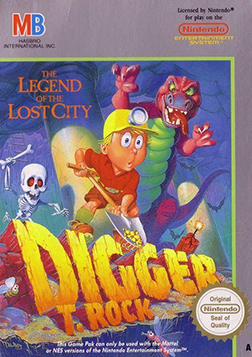
Digger T. Rock: Legend of the Lost City is a platform game developed by Rare and published by the Milton Bradley Company for the Nintendo Entertainment System. It was first released in North America in December 1990 and in Europe in 1991. The game centres around the miner Digger T. Rock, as he spelunks various caves and catacombs whilst searching for the mythical Lost City.

Killer Instinct Gold is a fighting game based on the arcade game Killer Instinct 2. The game was developed by Rare and released by Nintendo for the Nintendo 64. Players control characters who fight on a 2D plane set against a 3D background. Players press buttons to punch and kick their opponent in chains of successive hits, known as combos. Large combo successions lead to stronger attacks and brutal, stylistic finisher moves underscored by an announcer. Characters—including a gargoyle, a ninja, and a femme fatale—fight in settings such as a jungle and a spaceship. Killer Instinct Gold includes the arcade release's characters, combos, and 3D, pre-rendered environments, but excludes its full-motion video sequences and some voice-overs due to restrictions of the cartridge media format. The Gold release adds a training mode, camera views, and improved audiovisuals.

Battletoads Arcade, also known as Super Battletoads or just Battletoads, is a 1994 scrolling beat 'em up arcade game in the Battletoads series developed by Rare and published by Electronic Arts. Up to three players, as the Battletoads, brawl aliens and mutant rodents through six levels to save the universe from the Dark Queen. The game also includes vertical and bonus levels. Each Toad has its own signature attack, and as customary for the series, players can knock enemies towards the screen, breaking the fourth wall.

Brothers Tim and Chris Stamper are British entrepreneurs who founded the video game companies Ultimate Play the Game and Rare. They first worked together on arcade conversion kits, which were licensed to companies, but later became developers for the ZX Spectrum home computer in the early 1980s. Chris programmed the games, while Tim designed the graphics. They found success as Ultimate with games including Jetpac and Knight Lore. After reverse engineering the Nintendo Entertainment System and deciding to shift their focus to console development, the brothers founded Rare in the mid-1980s. They became Nintendo's first major Western developer, for whom they developed licensed games and ports. Over the next two decades, Rare enjoyed a close relationship with Nintendo and developed multiple major titles for the company, including Donkey Kong Country and GoldenEye 007. Microsoft acquired Rare in 2002, and the brothers left the company in 2007. After spending several years out of the public eye, the brothers are currently planning new ventures.





















